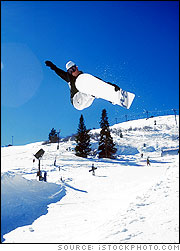Winter Olympics: Snowboarding

Very popular new sport
by Gerry Brown and Christine Frantz
 Related LinksDid You Know?According to the National Sporting Goods Association, U.S. consumers spent more than $234 million on snowboarding equipment in 2000. That's more than hockey and football equipment combined ($221 million). |
At Torino, snowboarding makes its third Olympic appearance. The sport, which first appeared at the 1998 Nagano Games, is still a work in progress as events are changed and added. For the 2006 Games, a new event, snowboard cross has been added.
There are six snowboarding events: men's and women's halfpipe, men's and women's parallel giant slalom, and men's and women's snowboard cross. The new snowboard cross event has a course made up of different sections: whoops (moguls), waves, banks, kickers, and spines (jumps with 90° angles), with a series of blue and red gates and triangular flags marking the course and indicating entrances to obstacles.
Each run is scored on a scale of 0.1 to 10.0 by a panel of five judges.
One judge scores the standardized moves, another scores amplitude (the height of maneuvers), one scores quality of rotations, and two score overall impression.
For the amplitude score each maneuver is given an additional point for every 30 centimeters that the competitor reaches above the lip of the pipe. The scores for each maneuver are averaged to determine the final amplitude score.
Falls and other mistakes lead to deductions. The format for point deduction in halfpipe is as follows:
- 0.1–0.4 for an unstable body, flat landing, or missed airs
- 0.5–0.9 for using hand for stability
- 1.0–1.5 for minor falls or body contact with the snow
- 1.6–1.9 for complete falls
- 2.0 for a complete stop
In the parallel giant slalom, the riders take qualifying runs, and the top 16 men and top 16 women are ranked according to their times. Then they face off in a bracket format with 1 facing 16, 2 facing 15, etc. The two competitors face in a two-race match (once on each course). The winner is the racer that posts the best total time.
The winners of each match move on to the next round until the semifinals. The two semifinals winners race for the gold (the loser gets the silver) and the semifinals losers race for the bronze.
The United States did well in 2002 at Salt Lake City with Ross Powers, Danny Kass, and Jarret Thomas sweeping the medals in the men's halfpipe. Kelly Clark took the women's halfpipe gold and Chis Klug grabbed a bronze in the men's parallel giant slalom. All are hoping to compete in Torin, but they'll have to contend with 2005's top World Cup boarders from Switzerland, Austria, France, and Japan.
Former X-Games champion and extreme sports pioneer Shaun Palmer made a run at the U.S. Snowboarding team in an attempt to medal in the newly added snowboarding event of snowboardcross (a pack-start downhill sprint), the same event he dominated for years in the late 1990s. At 37 years old and battling past trouble with drugs and alcohol, Palmer was a tremendous long shot, and a torn Achilles tendon suffered in a World Cup race in January derailed his inspirational comeback attempt. Without Palmer there, the Shaun to watch in Turin is redheaded mop-top Shaun White, a.k.a The Flying Tomato. The 19-year-old extreme sports demigod has proved he can compete on the concrete as well as the snow. White is also a world-class skateboarder and became the first athlete to compete in both the Summer and Winter X-Games. Snowboarding is still his strong suit as he proved this season by sweeping all five U.S. Grand Prix halfpipe events and crushing the competition in the superpipe at the 2006 Winter X-Games. You might have already seen one of his Pepsi commercials. If he takes gold in Turin, expect to see a lot more of Shaun White.







